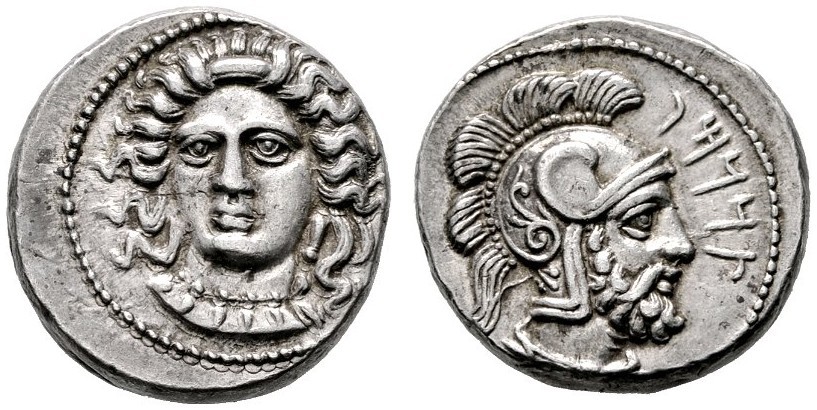Tarsus (Pharnabazus), silver, double sigloi (female head/Ares) (378-373 BCE)
From SILVER
378 BCE - 373 BCE Silver 28,838 kg
Description
| ObverseInscription or printing placed on the obverse.: | Aramaic BLTRZ to right (Aramaic).Ba'altars seated left, holding lotus-tipped scepter in extended right hand |
| ReverseInscription or printing placed on the reverse.: | Aramaic PRN-ZBW (Aramaic).Bearded male head (Ares?) left, wearing crested Attic helmet |
Mint and issuing power
| MintIdentifies the place of manufacture or issue of a numismatic object.: | Tarsus | Ancient regionAncient region.: | Cilicia | Modern countryModern country: Turkey | AuthorityIdentifies the issuing power. The authority can be "pretended" when the name or the portrait of X is on the coin but he/she was not the issuing power. It can also be "uncertain" when there is no mention of X on the coin but he/she was the issuing power according to the historical sources: | Persian Empire, Pharnabazus II (Achaemenid Persian Satrap in Asia Minor, c. 413-374 BC) |
Chronology
| FromIdentifies the initial date in a range assigned in a numismatic context. | 378 BCE | toIdentifies the final date in a range assigned in a numismatic context.. | 373 BCE | PeriodTime period of the numismatic object.: Classical 480-323 BC |
Physical description
| MetalThe physical material (usually metal) from which an object is made.: | Silver |
Median weightMedian of the weights of numismatic objects (in grams). in grams | 10.60 | DenominationTerm indicating the value of a numismatic object. Examples: tetradrachm, chalkous, denarius.: | double siglos |
StandardStandard.: | Persian |
Image

AC275 Tarsus.jpeg [1]
References
| Die study referencePublication of the study: | Moysey 19861Moysey 1986 | ||
| Coin series referenceReference to coin series study: | RQEMAC2RQEMAC, n° 275 | ||
| Coin series web referenceCoin series web references: | |||
Obverse dies distribution
| FrequencyFrequency of specimen in distribution. ᵖ | Number of obversesNumber of obverse dies. ᵖ (o) | % (o) | Number of coinsNumber of coins. (n) | % (n) | Die nameName(s) of the die(s). |
| 1 | 51 | 69.86 | 51 | 39.53 | 2, 3, 4, 5, 6, 7, 11, 13, 14, 15, 18, 19, 20, 21, 22, 24, 25, 26, 28, 31, 32, 33, 34, 36, 37, 39, 40, 41, 42, 44, 45, 47, 48, 49, 50, 51, 52, 53, 54, 60, 61, 62, 63, 64, 65, 66, 67, 68, 69, 70, 71 |
| 2 | 13 | 17.81 | 26 | 20.16 | 8, 9, 10, 16, 17, 23, 29, 30, 38, 46, 55, 57, 58 |
| 3 | 2 | 2.74 | 6 | 4.65 | 27, 59 |
| 4 | 2 | 2.74 | 8 | 6.2 | 43, 56 |
| 5 | 1 | 1.37 | 5 | 3.88 | 1 |
| 6 | 1 | 1.37 | 6 | 4.65 | 35 |
| 7 | 1 | 1.37 | 7 | 5.43 | 72 |
| 8 | 1 | 1.37 | 8 | 6.2 | 12 |
| 12 | 1 | 1.37 | 12 | 9.3 | 73 |
| Total | 73 of 73 | 100 | 129 of 129 | 100 |
Reverse dies distribution
no distribution is available
Quantification
| Number of obversesNumber of obverse dies. ᵖ (o) | 73 | Number of singletons (o1)The number of singleton coins. ᵖ | 51 |
| Number of reverse diesNumber of reverse dies. (r) | 107 | Number of coinsNumber of coins. (n) | 129 |
| Coins per obverse dieNumber of coins per obverse die. (n/o) | 1.77 | Coins per reverse dieNumber of coins per reverse die. (n/r) | 1.21 |
| Reverse per obverse ratioRatio of obverse dies divided by reverse dies. (r/o) | 1.47 | Percentage of singletons (o1)number of coins (n) divided by the number of singletons (o1) ᵖ | 69.86 % |
| Original number of dies (O) (Carter 1983 formula)The estimation of the number of coins according to Carter 1983 ᵖ | 136.03 | Coins struck if 20,000 as average productivity per dieCoins made if the average productivity for obverses (according to Carter) is 20,000. ᵖ | 2,720,600 |
| Original number of dies (O) (Esty 2011 formula)The estimation of the number of coins according to the singleton formula in Esty 2011 ᵖ (O) | 168.16 | Survival rate if 20,000 as average productivity per dieSurvival rate if average productivity is 20,000. ᵖ | 0.00005 |
| Coverage (o = % of O) (Esty 1984 formula)Esty 1984 - coverage (% of O) ᵖ (o = % of O) | 60.47% | Die productivity if survival rate 1/2,000Average productivity if survival rate is 1/2,000. ᵖ | 1,896.64 |
| Weight of silver (in kg) if 20,000 coins per die (O = Carter formula)Carter 1983 * Median weight * 20000 (*10 if gold or electrum) ᵖ | 28,838 kg <br /> 28,838 kg | Die productivity if survival rate 1/5,000Average productivity if survival rate is 1/5,000. ᵖ | 4,741.6 |
Remarks
Certainly military